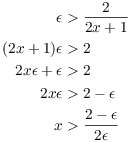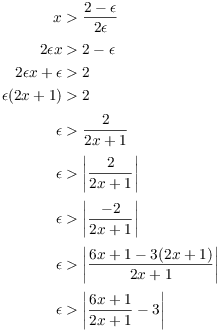In this section, I'll discuss proofs for limits of the form ![]() . They are like
. They are like ![]() proofs, though the setup and algebra are a
little different.
proofs, though the setup and algebra are a
little different.
Recall that ![]() means
that for every
means
that for every ![]() , there is a
, there is a ![]() such that if
such that if
![]()
Definition. ![]() means that for every
means that for every ![]() , there is an M such that if
, there is an M such that if
![]()
In other words, I can make ![]() as close to L as I
please by making x sufficiently large.
as close to L as I
please by making x sufficiently large.
Remarks. Limits at infinity often occur as limits of sequences, such as
![]()
In this case, ![]() . I won't make a distinction between the limit at
infinity of a sequence and the limit at infinity of a function; the
proofs you do are essentially the same in both cases.
. I won't make a distinction between the limit at
infinity of a sequence and the limit at infinity of a function; the
proofs you do are essentially the same in both cases.
There is s similar definition for ![]() , and the proofs are similar as well. I'll
stick to
, and the proofs are similar as well. I'll
stick to ![]() here.
here.
Example. Prove that ![]() .
.
As with ![]() proofs, I do some scratch work,
working backwards from what I want. Then I write the "real
proof" in the forward direction.
proofs, I do some scratch work,
working backwards from what I want. Then I write the "real
proof" in the forward direction.
Scratch work. I want
![]()
I want to drop the absolute values, so I'll assume ![]() . Rearranging the inequality, I get
. Rearranging the inequality, I get ![]() .
.
Here's the real proof. Let ![]() . Set
. Set ![]() . Since
. Since ![]() , I have
, I have ![]() . Suppose
. Suppose ![]() . Then
. Then ![]() , and
, and

This proves that ![]() .
.![]()
Example. Prove that ![]() .
.
Scratch work. I want
![]()
In order to drop the absolute values, I need to assume ![]() .
.
Rearrange the inequality:

Here's the real proof. Let ![]() . Set
. Set ![]() .
If
.
If ![]() , then
, then ![]() and
and ![]() . So
. So

Therefore,
![]()
Note that the expression ![]() would be negative if
would be negative if ![]() . So I took M to be the max of 0 and
. So I took M to be the max of 0 and ![]() to ensure that if
to ensure that if ![]() , then x would be positive. Now you actually need
, then x would be positive. Now you actually need
![]() to be positive in order to put on the
absolute values, and
to be positive in order to put on the
absolute values, and ![]() if
if ![]() . It isn't hard to prove that
. It isn't hard to prove that ![]() , so in fact I
don't need to take the max with 0 --- provided that I'm willing to
prove that
, so in fact I
don't need to take the max with 0 --- provided that I'm willing to
prove that ![]() . I decided to take the easy way out!
. I decided to take the easy way out!
Example. Prove that ![]() is undefined.
is undefined.
I'll use proof by contradiction. Suppose that
![]()
Taking ![]() in the definition,
I can find M such that if
in the definition,
I can find M such that if ![]() , then
, then ![]() .
.
Choose p to be an even number greater than M. Then
![]()
This says that the distance from L to 1 is less than ![]() , so
, so
![]()
Choose q to be an odd number greater than M. Then
![]()
This says that the distance from L to -1 is less than ![]() , so
, so
![]()
This is a contradiction, since L can't be in ![]() and in
and in ![]() at the same
time.
at the same
time.
Hence, ![]() is
undefined.
is
undefined.![]()
Copyright 2019 by Bruce Ikenaga